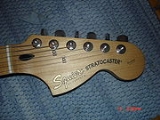
Headstock
Encyclopedia
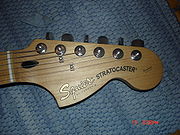
- This article is about part of a stringed instrument. A headstock is also the motorized chuck on a latheLatheA lathe is a machine tool which rotates the workpiece on its axis to perform various operations such as cutting, sanding, knurling, drilling, or deformation with tools that are applied to the workpiece to create an object which has symmetry about an axis of rotation.Lathes are used in woodturning,...
.
Headstock or peghead is a part of guitar
Guitar
The guitar is a plucked string instrument, usually played with fingers or a pick. The guitar consists of a body with a rigid neck to which the strings, generally six in number, are attached. Guitars are traditionally constructed of various woods and strung with animal gut or, more recently, with...
or similar stringed instrument. The main function of a headstock is holding the instrument's strings. Strings go from the bridge past the nut and are usually fixed on machine head
Machine head
A machine head is part of a string instrument ranging from guitars to double basses, a geared apparatus for applying tension and thereby tuning a string, usually located at the headstock. A headstock has several machine heads, one per string...
s on headstock. Machine heads are used to tune the guitar by adjusting the tension of strings and, consequentially, the pitch of sound they produce.
Construction details
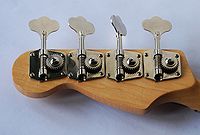
Steinberger
Steinberger refers to a series of distinctive electric guitars and bass guitars, designed and originally manufactured by Ned Steinberger. The word Steinberger can be used to refer to either the instruments themselves or the company that produced them...
guitar or some Chapman stick
Chapman Stick
The Chapman Stick is an electric musical instrument devised by Emmett Chapman in the early 1970s. A member of the guitar family, the Chapman Stick usually has ten or twelve individually tuned strings and has been used on music recordings to play bass lines, melody lines, chords or textures...
models.
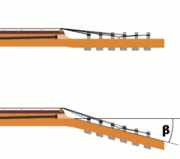
Woodworking joints
Joinery is a part of woodworking that involves joining together pieces of wood, to create furniture, structures, toys, and other items. Some wood joints employ fasteners, bindings, or adhesives, while others use only wood elements. The characteristics of wooden joints - strength, flexibility,...
(such as scarf joint
Scarf joint
A scarf joint is a method of joining two members end to end in woodworking or metalworking. The scarf joint is used when the material being joined is not available in the length required...
). There are two major trends in headstock construction, based on how the string will go after passing the nut. The advantages and disadvantages of both trends are very debatable and subjective, so these two variants are used:
- Straight headstocks form a single plane with a flat surface of neck (and fingerboard). This makes neck and headstock easier to manufacture, they can be constructed from a single piece of wood. Fender usually uses non-angled, straight headstocks. Because of the low angle of the string over the nut, string retainers (sometimes referred to as string trees for their tree shape) must be used to avoid the string coming out of the nut while playing.
- Angled headstocks form some kind of acute angle with a surface of neck. The value of "magic angle" (called headstock pitch) that gives the best tone and stability is also very debatable, but it is usually in a range from 3° to 25°. For example, various manufacturers and particular guitar models use:
- Guitars
- 4°: GuildGuild Guitar CompanyThe Guild Guitar Company is a USA-based guitar manufacturer founded in 1952 by Alfred Dronge, a guitarist and music-store owner, and George Mann, a former executive with the Epiphone Guitar Company...
- 11°: Martin
- 12°: BigsbyBigsbyThe Bigsby vibrato tailpiece is a type of vibrato device for electric guitar designed by Paul A. Bigsby. The device allows musicians to bend the pitch of notes or entire chords with their pick hand for various effects....
, Yamaha SGV - 13°: PeaveyPeavey ElectronicsPeavey Electronics Corporation is one of the largest audio equipment manufacturers in the world, headquartered in Meridian, Mississippi in the United States.- History :...
, Warmoth - 14°: Gibson FirebirdGibson FirebirdThe Gibson Firebird is a solid-body electric guitar manufactured by Gibson from 1963 to the present.-History:The Gibson Guitar Corporation released several new styles during the 1950s to compete with Fender's instruments, such as the Telecaster and Stratocaster. After success with the Les Paul in...
V and VII, Gibson X-plorerGibson ExplorerThe Gibson Explorer is a type of electric guitar that made its debut in 1958. The Explorer offered a radical, "futuristic" body design, much like its sibling, the Flying V. The Explorer was the final development of a prototype design which years later Gibson marketed under the name Futura.The...
, some vintage Gibson guitars, WashburnWashburn GuitarsWashburn Guitars is an American guitar manufacturer. It was established in 1883 in Chicago, Illinois. Washburn is a part of U.S. Music Corporation.- History :...
, most budget EpiphoneEpiphoneThe Epiphone Company is a musical instrument manufacturer founded in 1873 by Anastasios Stathopoulos. Epiphone was bought by Chicago Musical Instrument Company, which also owned Gibson Guitar Corporation, in 1957. Epiphone was Gibson's main rival in the archtop market...
replicas of Gibson models - 17°: Gibson ES-335Gibson ES-335The Gibson ES-335 is the world's first commercial thinline arched-top semi-acoustic electric guitar. Released by the Gibson Guitar Corporation as part of its ES series in 1958, it is neither hollow nor solid; instead, a solid wood block runs through the center of its body...
, Gibson Les PaulGibson Les PaulThe Gibson Les Paul was the result of a design collaboration between Gibson Guitar Corporation and the late jazz guitarist and electronics inventor Les Paul. In 1950, with the introduction of the Fender Telecaster to the musical market, electric guitars became a public craze. In reaction, Gibson...
, Gibson SGGibson SGAt the launch of the SG in 1961, Gibson offered four variants of the SG; the SG Junior , the SG Special, the SG Standard, and the top-of-the-line SG Custom. However, Gibson's current core variants as of 2010 are the SG Standard and the SG Special...
, EpiphoneEpiphoneThe Epiphone Company is a musical instrument manufacturer founded in 1873 by Anastasios Stathopoulos. Epiphone was bought by Chicago Musical Instrument Company, which also owned Gibson Guitar Corporation, in 1957. Epiphone was Gibson's main rival in the archtop market...
Casino
- 4°: Guild
- Basses
- 10°: all Gibson basses
- 12°: Yamaha SBV
- 14°: most Epiphone replicas of Gibson models
- 24°: Kinal
- Guitars
Luthier
Luthier
A luthier is someone who makes or repairs lutes and other string instruments. In the United States, the term is used interchangeably with a term for the specialty of each maker, such as violinmaker, guitar maker, lute maker, etc...
s of both styles frequently cite better sound, longer sustain
Sustain
In music, sustain is a parameter of musical sound over time. As its name implies, it denotes the period of time during which the sound remains before it becomes inaudible, or silent.Additionally, sustain is the third of the four segments in an ADSR envelope...
and strings staying in tune longer as advantages of each style. Fragile construction is cited as a disadvantage of each style too: single piece necks are more likely to break on occasional hit and are harder to repair, while glued-in necks can break with time.
Apart from its main function, the headstock is an important decorative detail of a guitar. It is the place where overwhelming majority of guitar manufacturers draw their logo
Logo
A logo is a graphic mark or emblem commonly used by commercial enterprises, organizations and even individuals to aid and promote instant public recognition...
. Some guitars without machine heads (for example, ones equipped with Floyd Rose SpeedLoader
Floyd Rose SpeedLoader
Floyd Rose SpeedLoader is a floating, double-locking, guitar bridge based on the Floyd Rose Original. It was in development since 1991 and was introduced to the public in 2003.This tremolo was developed in San Diego CA at AJ manufacturing by tool makers Jerry Morhman, Richard J Price, Steve lamms,...
) have a headstock for purely decorative reasons.
Signature headstock outlines


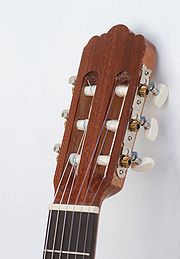
Matching headstock
On some electric guitars and basses (notably those made by FenderFender
Fender Musical Instruments Corporation, commonly referred to as simply Fender, of Scottsdale, Arizona is a manufacturer of stringed instruments and amplifiers, such as solid-body electric guitars, including the Stratocaster and the Telecaster...
), the finish used on the body is also applied to the face of the headstock. Generally, matched-headstock models carry a price premium over their plain counterparts due to the extra processes involved in the finishing process.
Although Fender no longer offers matched headstocks on production models made in the United States
United States
The United States of America is a federal constitutional republic comprising fifty states and a federal district...
or Mexico
Mexico
The United Mexican States , commonly known as Mexico , is a federal constitutional republic in North America. It is bordered on the north by the United States; on the south and west by the Pacific Ocean; on the southeast by Guatemala, Belize, and the Caribbean Sea; and on the east by the Gulf of...
, certain models from Fender Japan
Fender Japan
Fender Japan is the Japanese division of Fender Musical Instruments Corporation.-History:Fender Japan was officially created in March 1982 and consists of two Japanese Music companies that handle the ordering and distribution. The two companies are Yamano Gakki and Kanda Shokai...
are available with matched headstocks.
The definition of a "matched headstock" varies between manufacturers and players - for example, the headstocks of Gibson
Gibson
Gibson may refer to:* Gibson Amphitheatre* Gibson Appliance* Gibson Girl* Gibson Guitar Corporation* Gibson * Gibson Generating Station-Places:In the United States:* Gibson, Arkansas* Gibson, Georgia* Gibson, Iowa* Gibson, Louisiana...
guitars are nearly always black, and it is debatable whether a black-bodied Gibson has a matching headstock. Generally, a guitar is only considered to have a matching headstock if the guitar is usually produced without matching body and headstock finishes.

